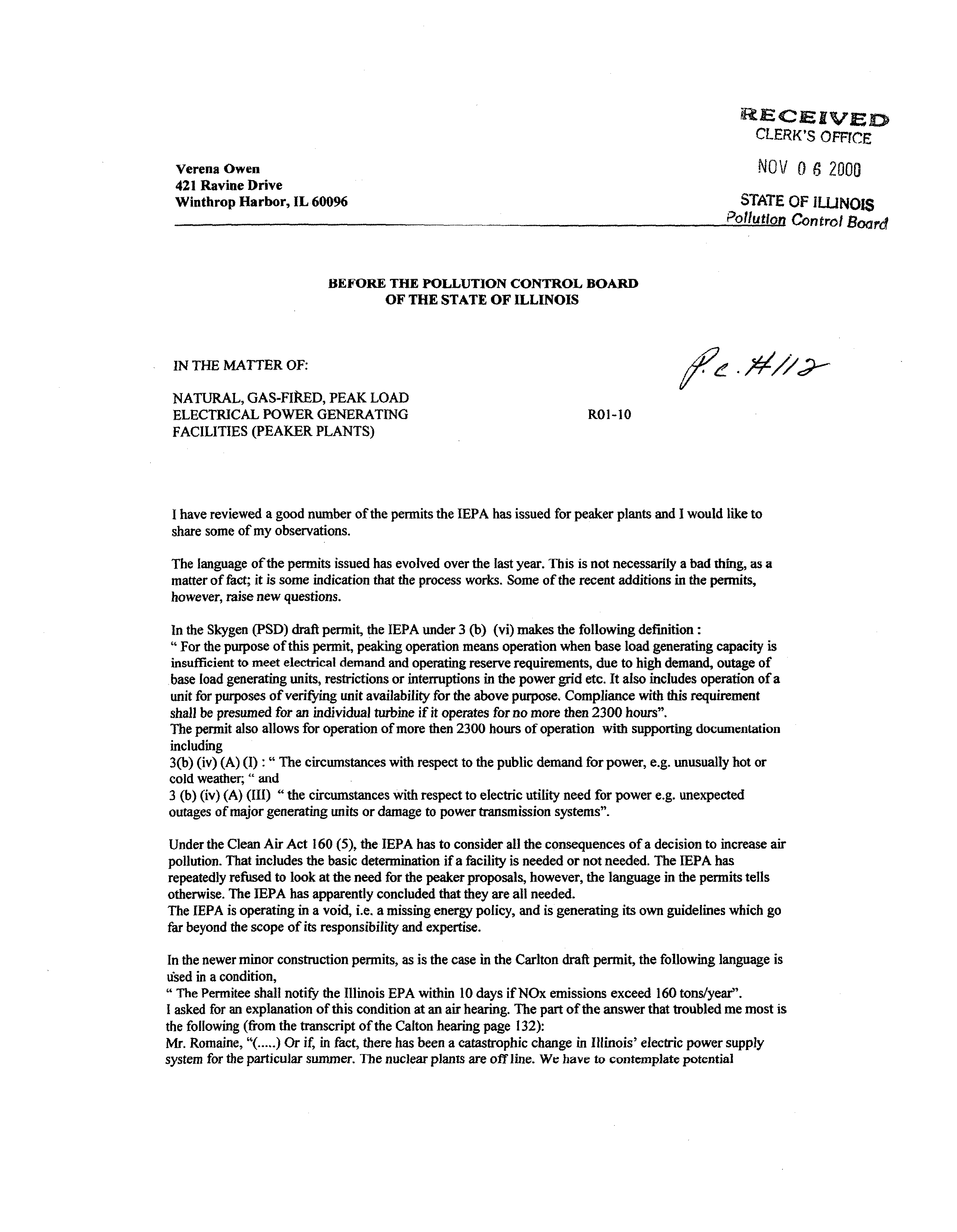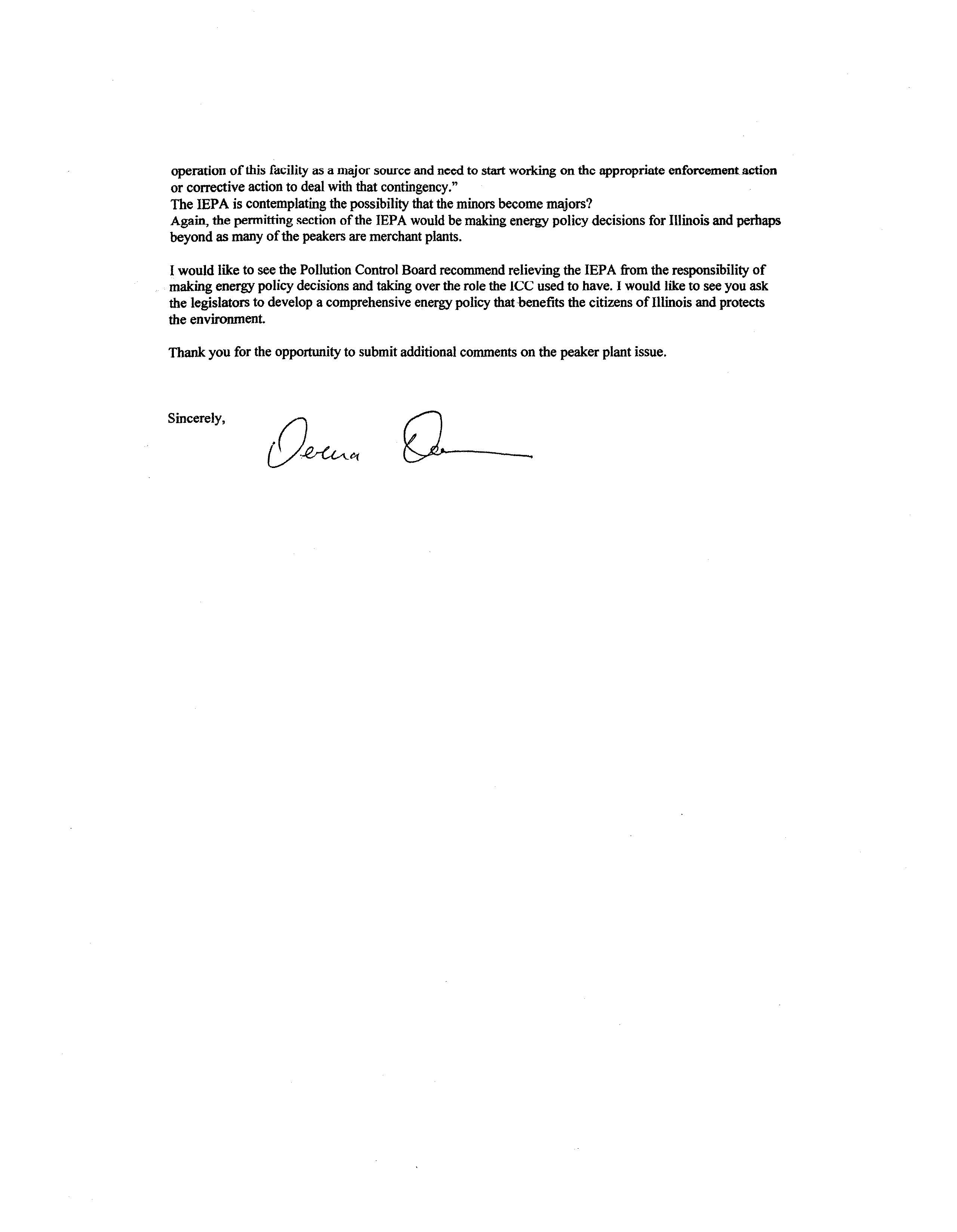RECEiVED
CLERK’S OFFICE
Verena Owen
NOV 0 ~ 2000
421 Ravine Drive
Winthrop Harbor, IL 60096
bTATE OF
Iwy~)~
_______________________________
Po1l~tj0~Control
Board
BEFORE
THE POLLUTION CONTROL BOARD
OF THE STATE OF ILLINOIS
iN THE
MATTER
OF:
~
NATURAL,
GAS-FIkED, PEAK LOAD
ELECTRICAL POWER GENERATfNG
ROl-lO
FACILITIES (PEAKER PLANTS)
I have reviewed a
good number of the permits the IEPA has
issued for
peaker plantsand
I would
like
to
share some of my observations.
The
language of the permits issued has evolved over the last year. This is not necessarily a bad thing, as a
matter of fact; it is some indication that the process works. Some ofthe recent additions in the permits,
however,raise new questions.
In the Skygen (PSD) draft permit, the IEPA under 3 (b) (vi) makes the following definition:
“For the purpose
of
this permit, peaking
operation means operation when
base load generating capacity is
insufficient to meet electrical demand and operating reserve requirements, due to high
demand, outage of
base load generating units, restrictions orintemiptions in the power
grid etc. It also includes operation
of a
unit for purposes
of
veri1~cingunit availability for the abovepurpose, Compliance with this requirement
shall be presumed for an individual turbine
if
it operates for no more then 2300 hours”.
The permit also allows for operation of more then 2300 hours of operation with supporting documentation
including
3(b) (iv) (A) (I)
:
“
The circumstances with respect to the public demand for power, e.g. unusually hot or
cold weather;
“
and
3 (b) (iv) (A) (III) “the circumstances with respect to electric utility need for powere.g. unexpected
outages ofmajor generating units ordamage to powertransmission systems”.
Under the Clean Air Act 160
(5),
the JEPA has to consider all the consequences of a decision to increase air
pollution. That includes the basic determination ifa facility is needed or not needed. The IEPA has
repeatedly refused to look at the need for the peaker proposals, however, the language in the permits tells
otherwise. The IEPA has apparently concluded that they are all needed.
The LEPA is operating in a void, i.e. a missing energy policy, and is generating its own guidelines which go
far beyond the scope of its responsibility and expertise.
In the newerminor construction permits, as is the case in the Canton draft permit, the following language is
u’sed in a condition,
“ThePermitee shall notify
the
Illinois EPA within 10 days ifNOx emissions exceed 160 tons/yea?’.
I asked for an explanation ofthis condition at an air hearing. The part ofthe answer that troubled me most is
the following (from the transcript ofthe Calton hearingpage 132):
Mr. Romaine,
“(
)
Or
if, in
fact, there has been a catastrophic change
in Illinois’ electric power supply
system
for the particular summer. The nuclear plants are
offline. We
have to contemplatepotential
operation of this facility as a major source and need to start working on the appropriateenforcementaction
or correctiveaction to deal with that contingency.”
The IEPA is contemplating the possibility that the minors become majors?
Again, the permitting section ofthe IEPA would be making energy policy decisions for Illinois and perhaps
beyond asmany ofthe peakers are merchant plants.
I would like to see the Pollution Control Board recommend relieving the IEPA from the responsibility of
making energy policy decisions and taking over the role the ICC used to have. I would like to see you ask
the legislators to develop a comprehensive energy policy that benefits the citizens ofIllinois and protects
the environment.
Thank you for the opportunity to submit additional comments on the peaker plant issue.
Sincerely,


